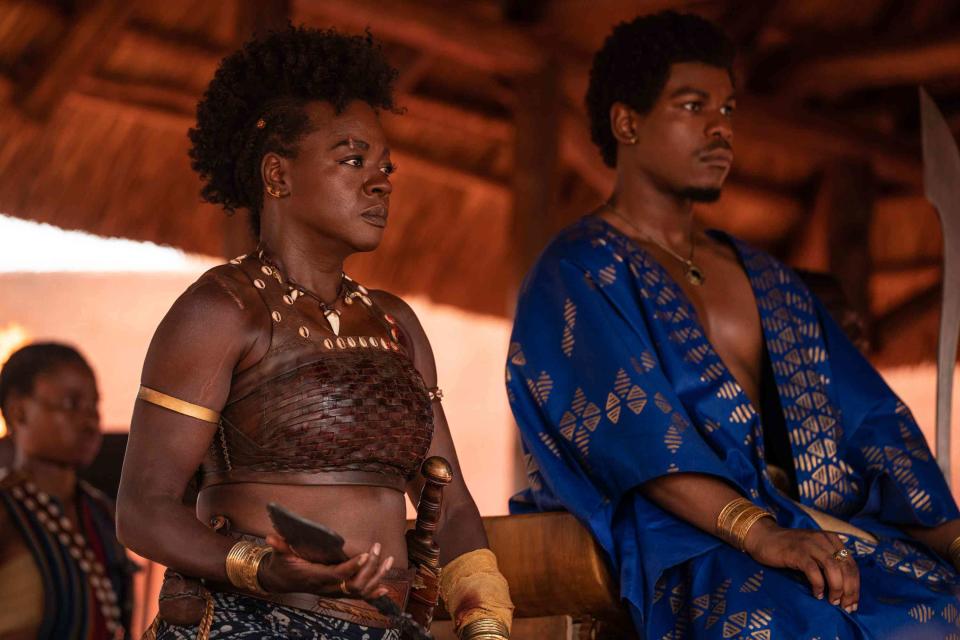The Hair and Makeup In 'The Woman King' Is an Ode to African Artistry
- Oops!Something went wrong.Please try again later.
Sophisticated, intelligent, and fierce.

Sony Pictures
The Woman King movie is one-of-one, telling the story of the Agojie, an army of women who belonged to the African kingdom of Dahomey (present-day Benin) in the 19th century.
As a part of a society that valued gender equality, this group of women were originally formed to take on the role of elephant hunters, then later became warriors who protected their land and people. In the film specifically, General Nanisca (Viola Davis) led the army to liberate Dahomean women who were abducted by the Oyo Empire and nearly sold into the slave trade — which eventually leads to an all-out war between the two states.
With a story as profound as this, it goes without saying that there was a lot of thought and detail put behind the hair and makeup for the film. The result is a true celebration of Black womanhood in its purest, rawest, and most majestic form.
Taking from the past 5,000 years of historical African hairstyling; the strength, authenticity, and fearlessness of the Agojie was inspiration enough for head hair designer Louisa Anthony to come up with culturally and historically accurate looks.
Anthony, who has worked on numerous TV and film sets, from A Thin Line Between Love and Hate and Hanging with Mr. Cooper to Black Panther and Coming 2 America, says she primarily focused on working with the actors' natural hair to create the various looks. From cropped coils to braids, each hairstyle is in alignment with that of the original Agojie women, however, tweaks were made based on the characters’ storyline, as well as the director, writers, and actors’ input. “The present is important, but the past is something to understand and embrace because it gives us a foundation to continue to soar,” Anthony shares with InStyle.
:
The spirit of female camaraderie was not only present on-screen, but also behind-the-scenes when it came to hairstyling. Seeing as The Woman King (which earned $19 million in its first weekend at the box office) was filmed in South Africa, Anthony's team partnered with 25 local women to learn new skills when it came to the artistry of braiding and protective styling.
While filming, the actors’ were on a regular co-washing regimen to avoid dryness. As for post-wash haircare, the team used a blend of leave-in conditioners and butters from brands like As I AM, Cantu, Mizani, African Pride, Pattern Beauty, and Carols Daughter to keep their delicate strands soft and protected from the scorching sun.
When it came to makeup, the goal was to make the characters look natural, yet still fierce — which can be difficult to translate on-screen.
“Usually, African skin is made to look very mucky and shiny [in film]," says head makeup artist Babalwa Mtshiselwa. "I wanted to show a celebration of Black skin, keep it as natural and as radiant as possible, highlighting the natural flawless beauty of dark skin."
Radiant and dewy with prosthetic scars was the brief for the makeup looks on The Woman King. In fact, Mtshiselwa says she kept adding scarring to the actors' bodies as the battle scenes got more intense throughout the film.
Mtshiselwa began by prepping the actors skin using translucent sunscreen from Eucerin. For glam, the makeup artist started off with MAC's Studio Fix Conceal and Correct Palette to ensure an even skin tone. Then she reached for products like Pat McGrath Labs Sublime Perfection Foundation to give the actors a sheer finish that seamlessly blended into their skin, alongside a conturing powder to add dimension to the face.
The special effects makeup, on the other hand, proved to be a challenge at some points. Part of the tactical strategy of the Agojie warriors was to never get caught by the enemy. To achieve this, the women had to oil themselves from head to toe, making it that much more challenging for the makeup team to make the prosthetic cuts and scarring work. However, seeing as she was on a time crunch, working with oily bodies, and filming in sunny Cape Town and KwaZulu-Natal, Mtshiselwa says her secret weapon was to use Pro Bondo, a well-known mould used for adding depth and texture to the skin.
While The Woman King may be a theatrical adaptation of the real Agojie and kingdom of Dahomey, what this level of representation both on and off-screen means for Black people watching — young and old — is unparalleled.
“If you want to tell a story about Africans, it has to be by Africans," says Mtshiselwa. "It’s empowering to be part of a world where young Black people can be inspired to be themselves and know that they are enough”.

